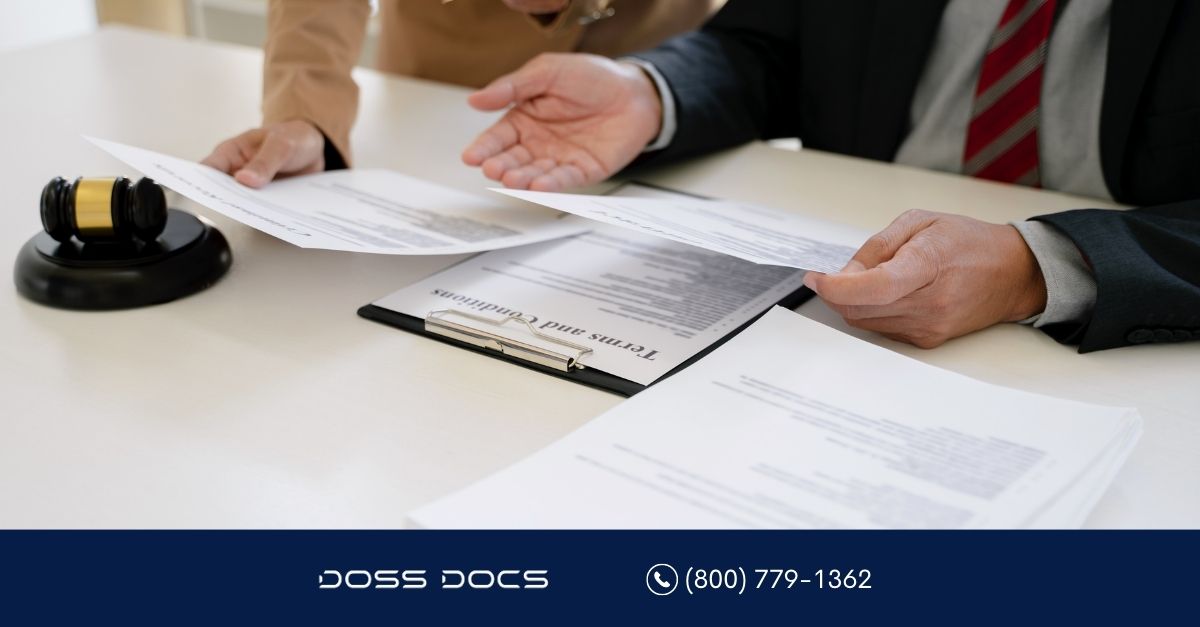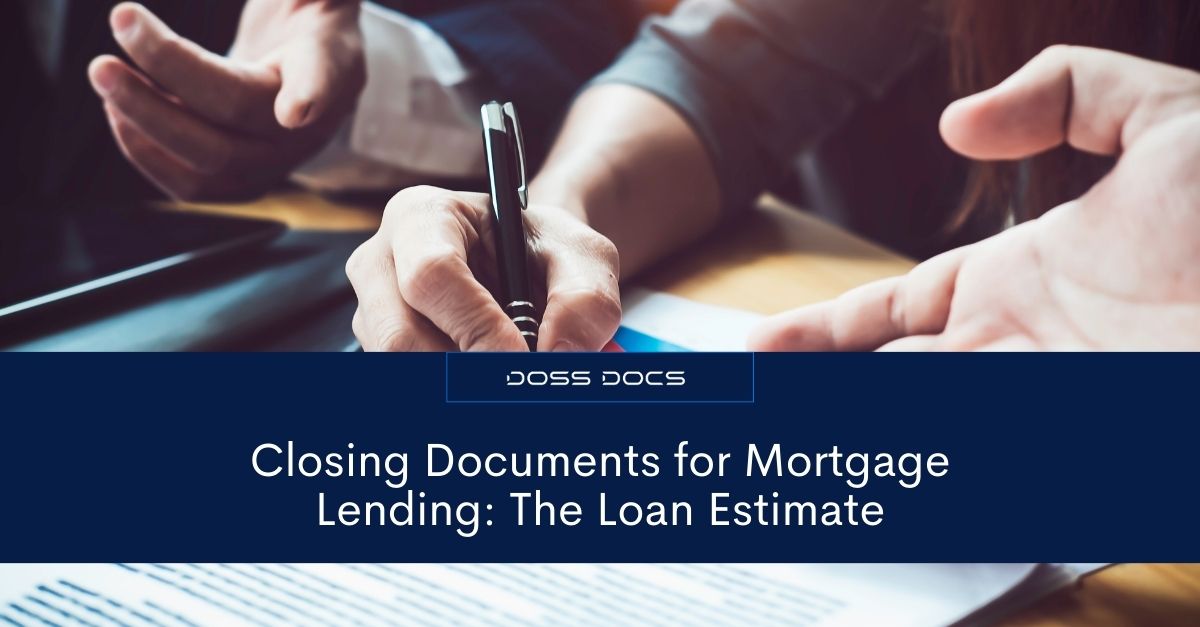Closing documents are indeed important when finalizing a mortgage loan. These documents allow you to comply with state and federal requirements, so keeping a list makes it simpler to ensure a successful closing and lending outcome. One of the required federal forms used is the Loan Estimate document. This form became official for lenders and borrowers on October 3, 2015.
To receive the form, a borrower must give the lender their social security number, address, property value, and the loan amount they’re seeking..
Reviewing the Loan Estimate Form
The three-page Loan Estimate form sets out important details about the mortgage loan application. The lender delivers a Loan Estimate three days after the borrower submits the mortgage application.
When reviewing the form, the borrower needs to make sure everything is correct so there won’t be any surprises.
This means they need to make sure the loan terms, purpose and loan type are correct and that the details are the same as what they discussed with the lender. This form allows the borrower to check and make sure that estimated total monthly payment is correct. Does it reflect what they expect to pay?
They also need to see items are listed under the Estimated Taxes, Insurance and Assessments that have not been escrowed. Estimated closing costs should be reviewed as well. The form also allows the borrower to see if they have enough money to pay the estimated cash they’ll need at the loan’s closing.
Therefore, the loan amount should be what they’re expecting to pay and they should know how the monthly principal and interest work. They also need to see if they’ll need to pay additional charges in the monthly payment.
Related Definitions
When reviewing this form, the borrower needs to understand certain definitions
Rate Lock
A rate lock means that the interest rate won’t change between the offer on the loan and the date of closing – as long as the loan closes within a specific time frame and no changes are made on the application.
Fixed and Adjustable Interest Rates
Fixed and adjustable rates are included on the form, with the info for the adjustable rate added to a table of projected payments and on other tables for review.
Prepayment Penalty
If the loan has a prepayment penalty for an early pay-off, this information will be stated on the Loan Estimate document. Preferably, it’s better to choose a loan that does not add this feature.
Balloon Payment
A risky feature, the balloon payment is a lump sum payment that is required at the end of a loan.
Monthly Principal and Interest (P&I)
The borrowed amount represents the principal while the interest is the lender’s charge for lending the money. Both are the main components of the Loan Estimate form. The total monthly payment is typically more than the P&I, as insurance and taxes are added into the projected loan amount.
What the Form Covers
The form gives the borrower the estimated payments for the following charges:
- Loan amount
- Rate of interest
- Monthly payment
- Closing costs
- Taxes and other costs
It also provides the basic loan details.
The Benefits of An Estimated Payment Form
The Estimated Payment form provides several advantages, namely the following:
- The borrower does not need to have a signed purchase contract to apply for mortgage lending.
- The borrower is not required to pay an application fee, other than a reasonable charge imposed for checking the borrower’s credit report.
- The borrower can get several Loan Estimates from various lenders to compare proposed mortgage or lending terms.
Important Considerations
Borrowers need to keep the following in mind when receiving a Loan Estimate:
- If the loan details change, the lender will submit a revised Loan Estimate.
- The interest rate on the Loan Estimate is not necessarily a guarantee. While some lenders will lock the interest rate, others may not.
- The borrower must communicate with their internet to proceed if they agree with the terms and details of the Loan Estimate document. Because a borrower can receive more than one Loan Estimate–from various lenders–it’s important for a borrower to let a lender know if they intend to go through with a loan.
The Difference Between the Loan Estimate and Closing Disclosure Form
While the Loan Estimate gives the borrower the approximate amount for monthly payments and closing costs, the Closing Disclosure features a final accounting for the cost of the mortgage loan.
Therefore, the Closing Disclosure is designed to inform the purchaser how much they’ll pay on their loan each month. The borrower has a window of three days to review the loan information and ask any question or correct an error.
Other Important Closing Documents
Other important closing documents include the following:
The Notice of the Right to Rescind
This form is used for loans that are used for obtaining a home equity line of credit or to refinance a home. The notice informs the borrower that they have three business days to cancel the loan and provides a cancellation form.
An Initial Escrow Statement
This statement features the estimated taxes, insurance costs, and other applicable lending charges paid from the borrower’s escrow account during the first year of the mortgage.
If a lender does not provide precise Truth-in-Lending disclosures on the Closing Disclosure form or does not provide two copies of a Right-to-Rescind form, the borrower has three years to nullify and cancel the lending agreement.
The Promissory Note
Details regarding the loan are covered in the promissory note, including:
- The amount owed
- The mortgage interest
- Payment dates
- Total that will be paid
- Length of repayment time
- Whether the payment amounts will change
- Where payments are sent
Mortgage Security Instrument
This form explains the borrowers’ responsibilities and rights.
State and Local Governmental Documents
These required forms fulfill the governmental regulation for collecting information and protecting the consumer.
Lender Documents
Any documents added by a lender, such as an Occupancy Affidavit. This type of lender documentation confirms that the real estate being financed will serve as the homeowner’s principal residence. Therefore, this document is the mortgagor’s written promise to the mortgagee that they will live in the real estate.
When a Lender Estimate Is Not Required
Borrowers who apply for a reverse mortgage do not receive a Loan Estimate or a Closing Disclosure. In this case, the intended mortgagor will receive a Good Faith Estimate (GFE) and an initial Truth-in-Lending Disclosure instead of the Loan Estimate. They’ll also receive a final Truth-in-Lending disclosure and HUD-1 settlement statement.

Contact Dos Docs for Your Closing Documents Anytime
Lenders and mortgage professionals know that the closing process can be long and drawn out. Therefore, it pays to use the services of a company that can provide the appropriate documents quickly and conveniently. Contact Dos Docs for all your mortgage forms today. Call 1-800-779-1362 for further details.


